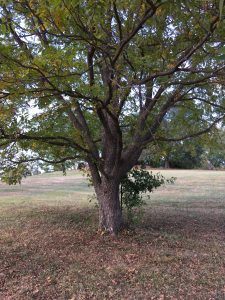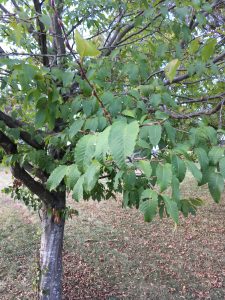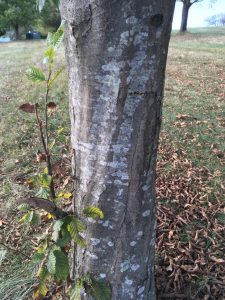
Cherry Tree
I observed my organisms on October 13, 2019 for an hour from 3:50-4:50.

Beech Tree
I chose to observe the two trees to the north of my sit spot that I have been following through all my blogs. I also took this opportunity to identify both trees because I have been interested in knowing what kind they were. Both trees sit to the north of my sit spot, I identified the smaller tree as a young beech (Fagus) and the larger tree as a cherry tree (Prunus). I chose to closely examine both because they provide so much to my blog post that it seems only fair that I understand a little more about them. They allow me to see many birds and sometimes squirrels while blogging from week to week. Ever since the first blog have felt the need to identify both trees that I spend most of my time watching, and this was the perfect opportunity to do so.
Upon further observation specific to my two trees I noticed more and more about them. The beech tree has big leaves for its size which made it seem a little unproportionate, but that just because it is so young, what few leaves are left are holding their green color very well. The leaves of this beech tree are the picturesque shape when one imagines leaves. The leaves have pointy/toothed edges all the way around with a sturdy stem to provide support. The bark of the tree is super smooth, which is a major clue that led me to identifying it as beech, this reminded me of a sycamore tree when the bark had peeled off. The bark is mostly grey-brown with a few spots of lighter grey mixed in. I noticed sever rows of woodpecker holes at the very base of the trunk, it would be so awesome if I go to see one, one day. I was a bit skeptical at first about this being a beech tree because there was no fruit to be found at my sit spot which is a major component to beech tree, but after conformation from Professor Liz I can confidently say it’s a young beech. Some natural history on Beech trees that I found interesting are the fact that the beech tree is well known for its fruit which have four plates covering the two nuts on the inside in a cup like shape, and they are edible! It was also interesting that only one out of the ten species under the Fagus genus is native to North America. Also that Beech trees hold their leaves year round however they do turn brown in the winter but remain on the tree, (except for mine but we’ll accredit that to the dry summer 😊)
The cherry tree has skinny leaves that are thicker on one side and slightly skinnier on the other, making the leaf curve toward the skinnier side ever so slightly. The tree is still holding almost all of its leaves, the same as last visit, however a yellow coloration is more noticeable now. The bark is incredibly rough and contains many cracks with distinguishable bark piece separation. I also noticed the bark further up the tree is peeling and reminds me of a sycamore trees peeling. I also found it interesting that a different species of tree is growing directly beside the large cherry tree at the base, maybe a maple. The cherry tree has thick strong branches which give it its lush canopy. I really enjoy observing this cherry because it brings most of the wildlife I get to observe while sitting at my sit spot, many many blue jays and sometimes squirrels. This always makes observations more enjoyable. I was able to finally identify this tree with the help of Professor Liz and with her expertise I was able to confirm that all of these aspects added up to a cherry tree. Cherry trees hold many traditions in countries such as Japan, when the cherry trees bloom it is the sign of oncoming spring and often a huge festival entail. The Japanese brought over thousands of cherry trees as a gift to Washington DC but were soon burned because they contained foreign diseases that were an ecological threat.
Overall this prompt was challenging in many ways, it was hard to identify the trees as there are so many possibilities that it was hard to narrow it down. I enjoyed getting to know my sit spot better and understand what I am observing now as the season goes on. Even when googling how to identify trees it really doesn’t narrow anything down unless you know in the ballpark of what you are identifying which I did not. The beech tree was less challenging then the cherry just because of the key characteristics that were very noticeable. After many google attempts and figuring out what the beech tree could possibly be, I turned to Professor Liz for help as I knew that was probably my best chance at figuring these out within the next century. Overall it was a challenge but who doesn’t love a good challenge, it was enjoyable and informative.

Beech Leaves

Beech Tree trunk

Cherry Tree leaves
References:
Nelson, G., Earle, C., Spellenberg, R., More, D., & Hughes, A. (2014). Trees of eastern North America (Princeton field guides).
Pauly, P. (1996). The Beauty and Menace of the Japanese Cherry Trees: Conflicting Visions of American Ecological Independence. Isis, 87(1), 51-73.


Aw that was such a cute gesture of the Japanese to send those cherry trees but that’s so sad they couldn’t be safely transferred. I guess it’s the thought that counts
I can see why identifying trees would be most difficult, but you did a good job! Also, your descriptions were top notch; they made me truly understand your organism.
Your descriptions of the trees made me notice their shape and helped me understand the trees better. Identifying the trees can be difficult especially when you have no clue where to start at.